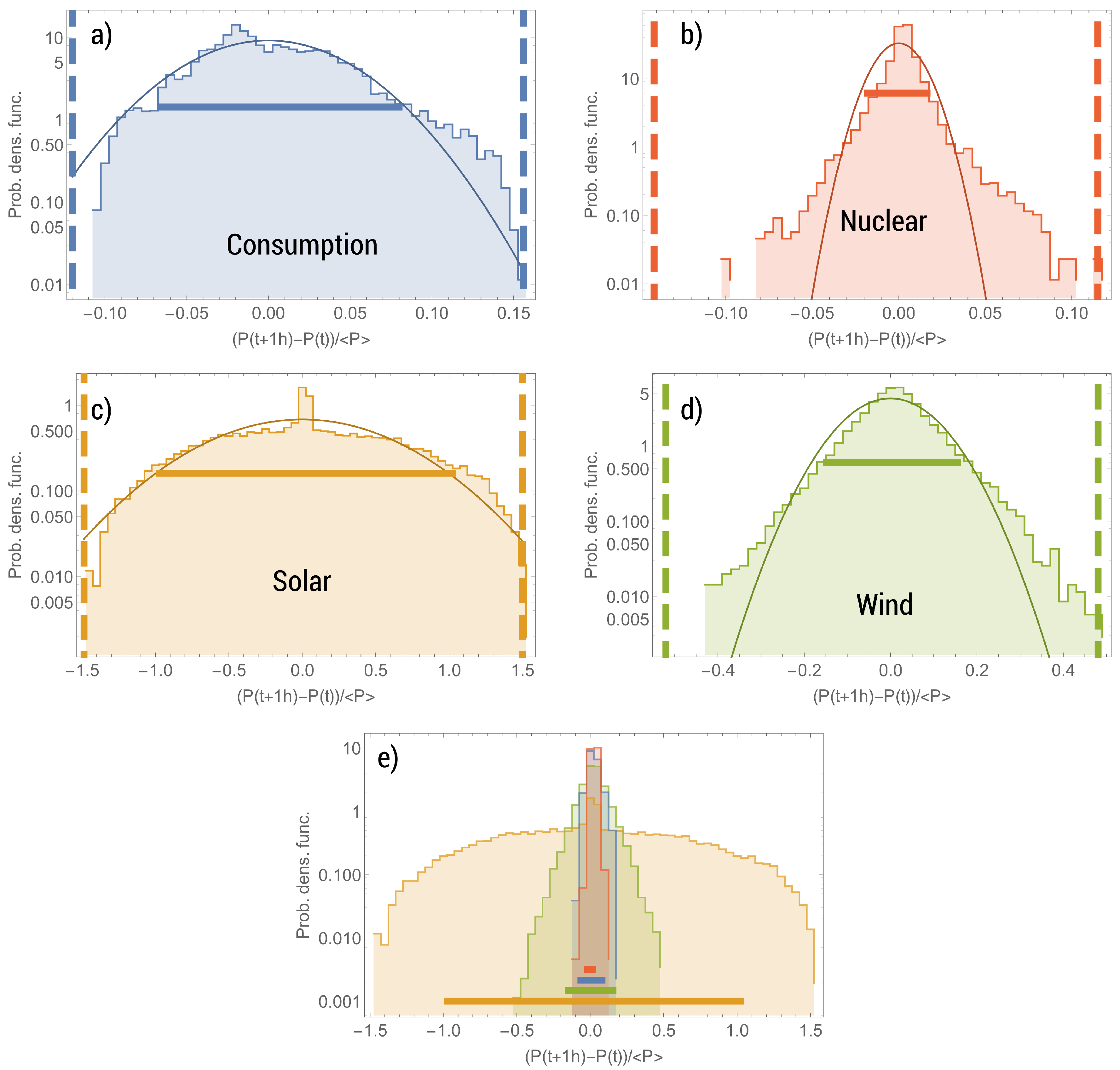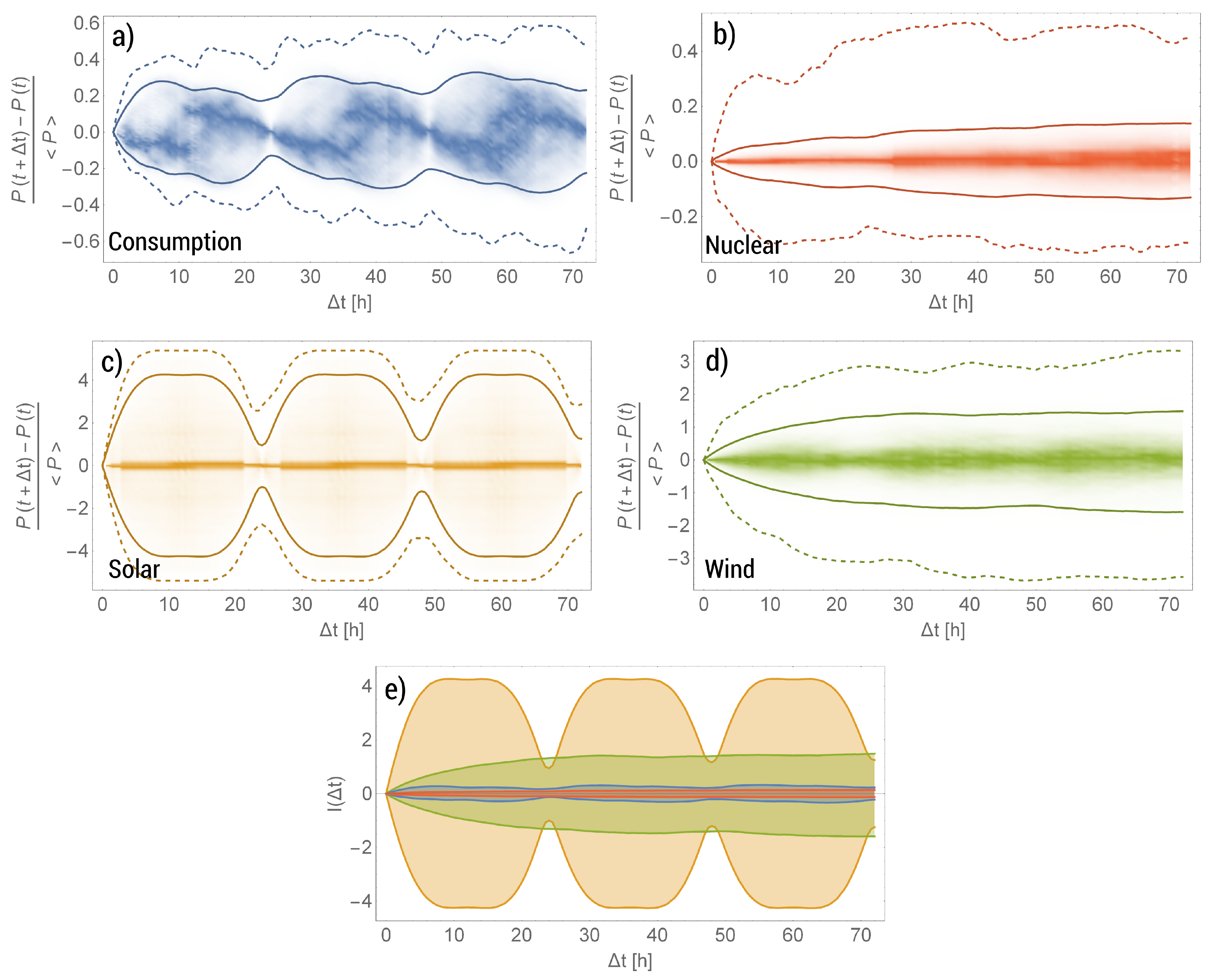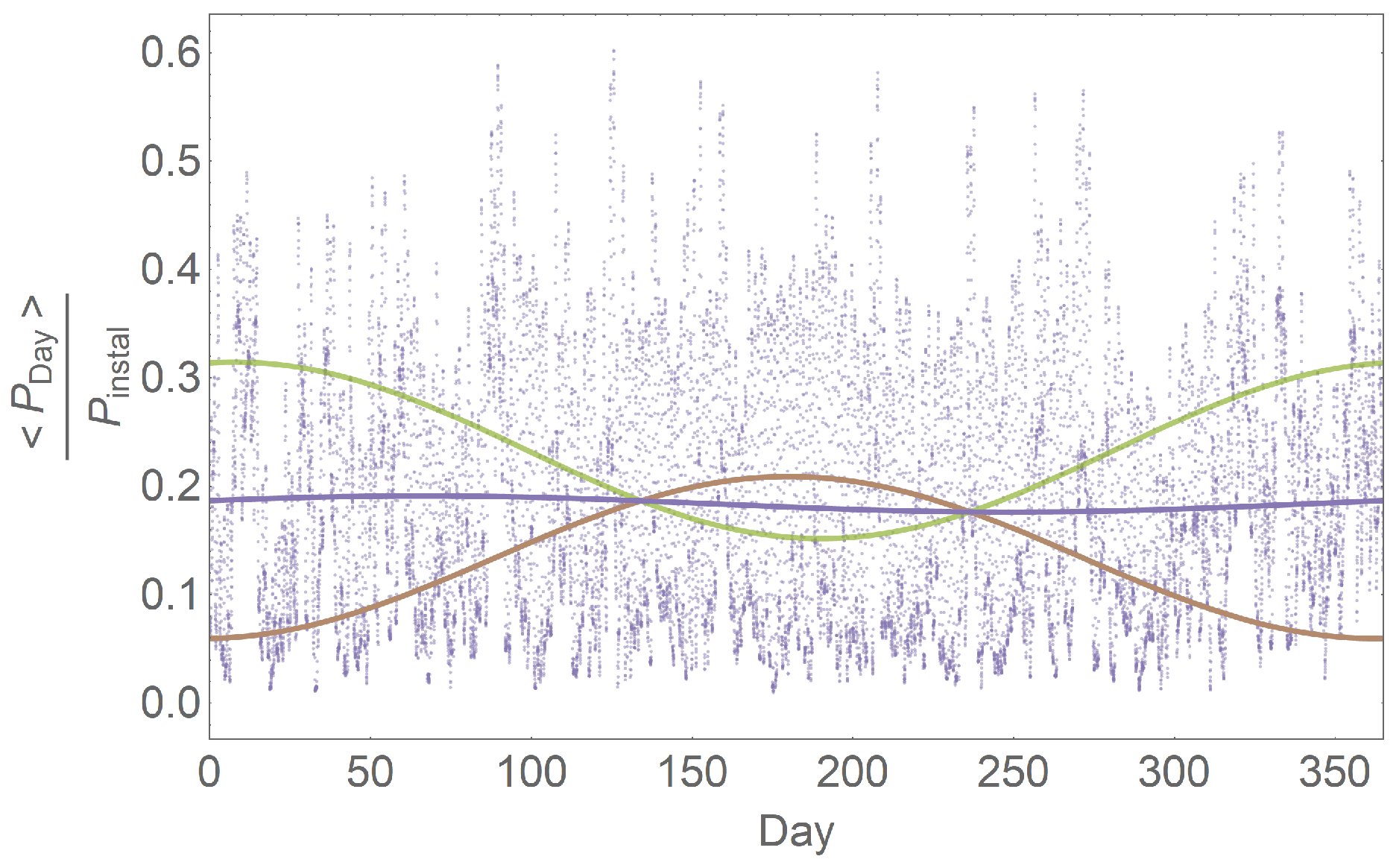Defining and Quantifying Intermittency in the Power Sector
Abstract
:1. Introduction
“The first point to be made, however, is that wind is [...] not ‘intermittent’. It is the output from ‘conventional’ sources of power that is intermittent. Although their characteristics vary considerably, problems with mechanical and electrical equipment, or with instrumentation, mean that sudden shutdowns—when up to 1000 megawatts (MW) or more of generation trips offline more or less instantaneously—are not uncommon”.[9]
“From the perspective of security of supply, wind power, despite all concerted efforts to expand since 2010, has for all practical purposes not replaced any conventional power plant capacity [...] Dispatchable complementary technologies are always necessary in conjunction with wind power.”[12]
2. Material and Methods
2.1. Background and Literature Review
2.2. Proposing a Systematic Indicator of Intermittency
“The indicator for intermittency of a power production (over a period ) is the spread of the relative deviations between its power at an instant t and its power at a later time , normalized by the average power .”
3. Results
3.1. Relative Power Differences at 1 h
3.2. Intermittency as a Function of Time
4. Discussion
4.1. Impact of Aggregation
4.2. Impact of Complementarity
5. Conclusions
Supplementary Materials
Author Contributions
Funding
Acknowledgments
Conflicts of Interest
References
- IRENA. Renewable Capacity Statistics 2019; Technical Report 978-92-9260-123-2; IRENA: Abu Dhabi, UAE, 2019. [Google Scholar]
- International Energy Agency. Getting Wind and Sun onto the Grid, a Manual for Policy Makers; International Energy Agency: Paris, France, 2017. [Google Scholar]
- Heptonstall, P.; Gross, R.; Steiner, F. The Costs and Impacts of Intermittency, 2016 Update; UK Energy Research Center: London, UK, 2017. [Google Scholar]
- Wagner, F. Electricity by intermittent sources: An analysis based on the German situation 2012. Eur. Phys. J. Plus 2014, 129. [Google Scholar] [CrossRef] [Green Version]
- Clack, C.T.M.; Qvist, S.A.; Apt, J.; Bazilian, M.; Brandt, A.R.; Caldeira, K.; Davis, S.J.; Diakov, V.; Handschy, M.A.; Hines, P.D.H.; et al. Evaluation of a proposal for reliable low-cost grid power with 100% wind, water, and solar. Proc. Natl. Acad. Sci. USA 2017, 114, 6722–6727. [Google Scholar] [CrossRef] [PubMed] [Green Version]
- Heard, B.; Brook, B.; Wigley, T.; Bradshaw, C. Burden of proof: A comprehensive review of the feasibility of 100% renewable-electricity systems. Renew. Sustain. Energy Rev. 2017, 76, 1122–1133. [Google Scholar] [CrossRef]
- Budischak, C.; Sewell, D.; Thomson, H.; Mach, L.; Veron, D.E.; Kempton, W. Cost-minimized combinations of wind power, solar power and electrochemical storage, powering the grid up to 99.9% of the time. J. Power Sources 2013, 225, 60–74. [Google Scholar] [CrossRef] [Green Version]
- Jacobson, M.Z.; Delucchi, M.A.; Cameron, M.A.; Frew, B.A. Low-cost solution to the grid reliability problem with 100% penetration of intermittent wind, water, and solar for all purposes. Proc. Natl. Acad. Sci. USA 2015, 112, 15060–15065. [Google Scholar] [CrossRef] [PubMed] [Green Version]
- Milborrow, D. Wind Power on the Grid. In Renewable Electricity and the Grid, the Challenge of Variability; Boyle, G., Ed.; Earthscan: London, UK, 2007. [Google Scholar]
- Lovins, A.B.; Sheikh, I.; Markevich, A. Nuclear power: Climate fix or folly? In The Energy Reader; Nader, L., Ed.; John Wiley & Sons: Hoboken, NJ, USA, 2010. [Google Scholar]
- Inhaber, H. Why wind power does not deliver the expected emissions reductions. Renew. Sustain. Energy Rev. 2011, 15, 2557–2562. [Google Scholar] [CrossRef]
- Linnemann, T.; Vallana, G.S. Wind energy in Germany and Europe. Pt. 2. Status, potentials and challenges for baseload application: European situation in 2017. Atw. Int. Z. Kernenerg. 2019, 64, 141–148. [Google Scholar]
- MacKay, D. Sustainable Energy—Without the Hot Air; UIT Cambridge Ltd.: Cambridge, UK, 2009; p. 384. [Google Scholar]
- Négawatt, A. Are Renewable Energy Sources Intermittent? 2016. Available online: https://decrypterlenergie.org/les-energies-renouvelables-sont-elles-intermittentes-2 (accessed on 25 June 2020).
- Association “Save the Climate”. Wind and Solar Electricity Production, CO2 Emission and Cost of Electricity for Households in Western Europe. 2017. Available online: https://www.sauvonsleclimat.org/fr/base-documentaire/electricite-renouvelable-intermittente-europe (accessed on 25 June 2020).
- Greenpeace France. Electricity Market: Who Are the Greener Electricity Providers? Technical Report. 2018. Available online: https://www.guide-electricite-verte.fr/wp-content/uploads/sites/9/2018/09/Guide-electriciteverte-2018-Methodologie-Greenpeace-France.pdf (accessed on 10 October 2018). See also: https://www.liberation.fr/checknews/2018/10/05/selon-greenpeace-le-nucleaire-emet-plus-deco2-que-le-photovoltaique-est-ce-vrai_1682628 (accessed on 25 June 2020) .
- Tarroja, B.; Mueller, F.; Eichman, J.D.; Samuelsen, S. Metrics for evaluating the impacts of intermittent renewable generation on utility load-balancing. Energy 2012, 42, 546–562. [Google Scholar] [CrossRef]
- Chang, M.K.; Eichman, J.D.; Mueller, F.; Samuelsen, S. Buffering intermittent renewable power with hydroelectric generation: A case study in California. Appl. Energy 2013, 112, 1–11. [Google Scholar] [CrossRef]
- Gutierrez-Martín, F.; Da Silva Alvarez, R.; Montoro-Pintado, P. Effects of wind intermittency on reduction of CO2 emissions: The case of the Spanish power system. Energy 2013, 61, 108–117. [Google Scholar] [CrossRef]
- Réseau Transport Electricité (French Electricity Transmission Network). Definitive and Consolidated Domestic eCO2-Mix Data. 2018. Available online: https://www.rte-france.com/en/eco2mix/eco2mix-telechargement-en (accessed on 25 June 2020).
- French Ministry for the Economy and Finance. Loi 2000-108 du 10 Février 2000 Relative à la Modernisation et au Développement du Service Public de l’électricité (ECOX 9800166L); French Ministry for the Economy and Finance: Paris, France, 2016. [Google Scholar]
- Coker, P.; Barlow, J.; Cockerill, T.; Shipworth, D. Measuring significant variability characteristics: An assessment of three UK renewables. Renew. Energy 2013, 53, 111–120. [Google Scholar] [CrossRef]
- Ren, G.; Liu, J.; Wan, J.; Guo, Y.; Yu, D.; Liu, J. Measurement and statistical analysis of wind speed intermittency. Energy 2017, 118, 632–643. [Google Scholar] [CrossRef]
- Sinden, G. Characteristics of the UK wind resource: Long-term patterns and relationship to electricity demand. Energy Policy 2007, 35, 112–127. [Google Scholar] [CrossRef]
- Masters, G.M. Renewable and Efficient Electric Power Systems; John Wiley & Sons Inc.: Hoboken, NJ, USA, 2013. [Google Scholar]
- Wilks, D.S. Statistical Methods in the Atmospheric Sciences; International Geophysics Series; Elsevier: Amsterdam, The Netherlands; Academic Press: Cambridge, MA, USA, 2011. [Google Scholar]
- Apt, J. The spectrum of power from wind turbines. J. Power Sources 2007, 169, 369–374. [Google Scholar] [CrossRef]
- Van der Hoven, I. Power spectrum of the horizontal wind speed in the frequency range from 0.0007 to 900 cycles per hour. J. Meteor. 1957, 14, 160–164. [Google Scholar] [CrossRef] [Green Version]
- Tarroja, B.; Mueller, F.; Eichman, J.D.; Brouwer, J.; Samuelsen, S. Spatial and temporal analysis of electric wind generation intermittency and dynamics. Renew. Energy 2011, 36, 3424–3432. [Google Scholar] [CrossRef] [Green Version]
- Ghashghaie, S.; Breymann, W.; Peinke, J.; Talkner, P.; Dodge, Y. Turbulent cascades in foreign exchange markets. Nature 1996, 381, 767–770. [Google Scholar] [CrossRef]
- Morales, A.; Wachter, M.; Peinke, J. Characterization of wind turbulence by higher-order statistics: Characterization of atmospheric turbulence. Wind Energy 2012, 15, 391–406. [Google Scholar] [CrossRef]
- Anvari, M.; Lohmann, G.; Wächter, M.; Milan, P.; Lorenz, E.; Heinemann, D.; Tabar, M.R.R.; Peinke, J. Short term fluctuations of wind and solar power systems. New J. Phys. 2016, 18, 063027. [Google Scholar] [CrossRef]
- Kiviluoma, J.; Holttinen, H.; Weir, D.; Scharff, R.; Söder, L.; Menemenlis, N.; Cutululis, N.A.; Danti Lopez, I.; Lannoye, E.; Estanqueiro, A.; et al. Variability in large-scale wind power generation. Wind Energy 2016, 19, 1649–1665. [Google Scholar] [CrossRef] [Green Version]
- Livet, F. The Problem of Intermittency of Renewable Energies: Solar and Wind Energy; Technical Report INIS-FR–14-0410; IAEA-INIS: Vienna, Austria, 2011. [Google Scholar]
- Flocard, H.; Pervès, J.P.; Hulot, J.P. Electricité: Intermittence et foisonnement des énergies renouvelables. Techniques de l’Ingénieur 2014, 202, BE8586. [Google Scholar]
- European Network of Transmission System Operators for Electricity Transparency Platform. Actual Generation per Production Type. 2018. Available online: https://transparency.entsoe.eu/ (accessed on 25 June 2020).
- Grams, C.M.; Beerli, R.; Pfenninger, S.; Staffell, I.; Wernli, H. Balancing Europe wind-power output through spatial deployment informed by weather regimes. Nat. Clim. Chang. 2017, 7, 557–562. [Google Scholar] [CrossRef] [PubMed] [Green Version]





© 2020 by the authors. Licensee MDPI, Basel, Switzerland. This article is an open access article distributed under the terms and conditions of the Creative Commons Attribution (CC BY) license (http://creativecommons.org/licenses/by/4.0/).
Share and Cite
Suchet, D.; Jeantet, A.; Elghozi, T.; Jehl, Z. Defining and Quantifying Intermittency in the Power Sector. Energies 2020, 13, 3366. https://doi.org/10.3390/en13133366
Suchet D, Jeantet A, Elghozi T, Jehl Z. Defining and Quantifying Intermittency in the Power Sector. Energies. 2020; 13(13):3366. https://doi.org/10.3390/en13133366
Chicago/Turabian StyleSuchet, Daniel, Adrien Jeantet, Thomas Elghozi, and Zacharie Jehl. 2020. "Defining and Quantifying Intermittency in the Power Sector" Energies 13, no. 13: 3366. https://doi.org/10.3390/en13133366
APA StyleSuchet, D., Jeantet, A., Elghozi, T., & Jehl, Z. (2020). Defining and Quantifying Intermittency in the Power Sector. Energies, 13(13), 3366. https://doi.org/10.3390/en13133366





